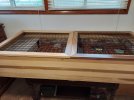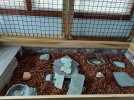Hello everyone,
I am just over a week away from bringing a juvenile Pancake Tortoise into my home. This will be my first experience caring for a reptile of any kind. Virtually everything is ready to go, aside from the lighting. Very early on in my reading I purchased an 80 watt mercury vapor bulb and fixture, but I appreciate that there are many options for heating and lighting and that my table may require more than a lone all-in-one bulb to adequately meet the temperature and UV needs of this animal.
Complicating things further is that I've got a wire mesh lid over the table, seen in the attached pictures, which as I understand will block some of the effectiveness of the bulbs I put in place. As such, I'm just not entirely certain how best to proceed. I've read a fair bit about fluorescent UVB bulbs, mercury vapor bulbs, halogen lights, and ceramic heat emitters, but am not sure as to which combination of these will provide the best environment possible for a tortoise that will spend the bulk of its time indoors. Any insight would be much appreciated, and I am open to all suggestions. I'll also answer any questions, if more information is needed.
Thanks in advance. I'll do what it takes to get this right.



I am just over a week away from bringing a juvenile Pancake Tortoise into my home. This will be my first experience caring for a reptile of any kind. Virtually everything is ready to go, aside from the lighting. Very early on in my reading I purchased an 80 watt mercury vapor bulb and fixture, but I appreciate that there are many options for heating and lighting and that my table may require more than a lone all-in-one bulb to adequately meet the temperature and UV needs of this animal.
Complicating things further is that I've got a wire mesh lid over the table, seen in the attached pictures, which as I understand will block some of the effectiveness of the bulbs I put in place. As such, I'm just not entirely certain how best to proceed. I've read a fair bit about fluorescent UVB bulbs, mercury vapor bulbs, halogen lights, and ceramic heat emitters, but am not sure as to which combination of these will provide the best environment possible for a tortoise that will spend the bulk of its time indoors. Any insight would be much appreciated, and I am open to all suggestions. I'll also answer any questions, if more information is needed.
Thanks in advance. I'll do what it takes to get this right.



